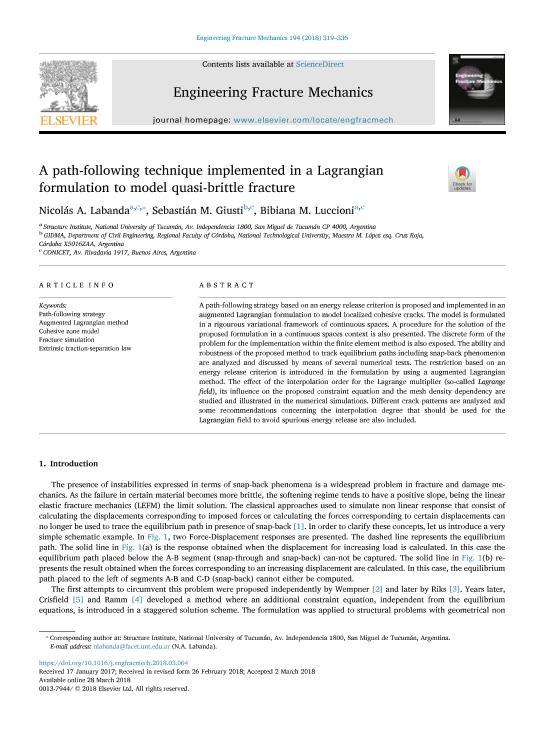Mostrar el registro sencillo del ítem
dc.contributor.author
Labanda, Nicolás Agustín

dc.contributor.author
Giusti, Sebastian Miguel

dc.contributor.author
Luccioni, Bibiana Maria

dc.date.available
2019-08-12T17:15:31Z
dc.date.issued
2018-03
dc.identifier.citation
Labanda, Nicolás Agustín; Giusti, Sebastian Miguel; Luccioni, Bibiana Maria; A Path-following technique implemented in a Lagrangian formulation to model quasi-brittle fracture; Pergamon-Elsevier Science Ltd; Engineering Fracture Mechanics; 194; 5; 3-2018; 319-336
dc.identifier.issn
0013-7944
dc.identifier.uri
http://hdl.handle.net/11336/81444
dc.description.abstract
A path-following strategy based on an energy release criterion is proposed and implemented in an augmented Lagrangian formulation to model localized cohesive cracks. The model is formulated in a rigourous variational framework of continuous spaces. A procedure for the solution of the proposed formulation in a continuous spaces context is also presented. The discrete form of the problem for the implementation within the finite element method is also exposed. The ability and robustness of the proposed method to track equilibrium paths including snap-back phenomenon are analyzed and discussed by means of several numerical tests. The restriction based on an energy release criterion is introduced in the formulation by using a augmented Lagrangian method. The effect of the interpolation order for the Lagrange multiplier (so-called Lagrange field), its influence on the proposed constraint equation and the mesh density dependency are studied and illustrated in the numerical simulations. Different crack patterns are analyzed and some recommendations concerning the interpolation degree that should be used for the Lagrangian field to avoid spurious energy release are also included.
dc.format
application/pdf
dc.language.iso
eng
dc.publisher
Pergamon-Elsevier Science Ltd

dc.rights
info:eu-repo/semantics/openAccess
dc.rights.uri
https://creativecommons.org/licenses/by-nc-sa/2.5/ar/
dc.subject
Path-Following Strategy
dc.subject
Augmented Lagrangian Method
dc.subject
Cohesive Zone Model
dc.subject
Fracture Simulation
dc.subject
Extrinsic Traction-Separation Law
dc.subject.classification
Matemática Aplicada

dc.subject.classification
Matemáticas

dc.subject.classification
CIENCIAS NATURALES Y EXACTAS

dc.title
A Path-following technique implemented in a Lagrangian formulation to model quasi-brittle fracture
dc.type
info:eu-repo/semantics/article
dc.type
info:ar-repo/semantics/artículo
dc.type
info:eu-repo/semantics/publishedVersion
dc.date.updated
2019-08-07T14:09:10Z
dc.journal.volume
194
dc.journal.number
5
dc.journal.pagination
319-336
dc.journal.pais
Estados Unidos

dc.journal.ciudad
Amsterdam
dc.description.fil
Fil: Labanda, Nicolás Agustín. Universidad Nacional de Tucumán. Facultad de Ciencias Exactas y Tecnología. Instituto de Estructuras "Ing. Arturo M. Guzmán"; Argentina. Consejo Nacional de Investigaciones Científicas y Técnicas. Centro Científico Tecnológico Conicet - Tucumán; Argentina
dc.description.fil
Fil: Giusti, Sebastian Miguel. Universidad Tecnológica Nacional; Argentina. Consejo Nacional de Investigaciones Científicas y Técnicas. Centro Científico Tecnológico Conicet - Tucumán; Argentina
dc.description.fil
Fil: Luccioni, Bibiana Maria. Universidad Nacional de Tucumán. Facultad de Ciencias Exactas y Tecnología. Instituto de Estructuras "Ing. Arturo M. Guzmán"; Argentina. Consejo Nacional de Investigaciones Científicas y Técnicas. Centro Científico Tecnológico Conicet - Tucumán; Argentina
dc.journal.title
Engineering Fracture Mechanics

dc.relation.alternativeid
info:eu-repo/semantics/altIdentifier/url/https://www.sciencedirect.com/science/article/pii/S0013794417300863/pdfft?md5=f122b79c6dadf7d2641ee6d63172e288&pid=1-s2.0-S0013794417300863-main.pdf
dc.relation.alternativeid
info:eu-repo/semantics/altIdentifier/url/https://doi.org/10.1016/j.engfracmech.2018.03.004
Archivos asociados
